Drugs
Illegal production, trafficking and smuggling of drugs in Serbia represent a very high-level security threat.
Most registered OCGs deal with this very dynamic type of transnational crime, but are also involved in the international purchase and distribution of drugs.
Illegal production, trafficking and smuggling of drugs pose a great danger to citizens’ safety and public health. They are among the most profitable and widespread types of organized crime, which the largest number of identified organized crime groups deal with. The social danger of this type of crime is extremely high, primarily in the social, medical and economic contexts. Moreover, it is conducive to the great financial power of participants in organized drug-related crimes, their corruptive influence, as well as the infiltration of illegal proceeds into legal financial flows. It is connected with other types of organized crime, and also results in violent crimes, which are committed within fight for prevalence on the criminal market and territory.
According to their age, social situation and education, drug users are a heterogenous population that commits different property crimes in order to get money for drugs. According to data, in 2021, more than 296 million people in the world used some kind of drugs, which represented an increase of 23% against the previous decades. On the other hand, the number of those suffering from drug use disorders jumped to 39.5 million, increasing by 45% over the last ten years. According to estimates, the number of drug users in the world will increase by 11% by 2030.
During the COVID-19 pandemic, as a result of the total suspension of air traffic and closure of state borders to passenger traffic, the only way to smuggle drugs was to transport them in freight vehicles together with the legitimate cargo. According to the 2021 World Drug Report, after the beginning of the COVID-19 pandemic, the drug market quickly regenerated, and some types of trafficking even intensified – which was the case with maritime routes, “contactless” delivery, bulk delivery, etc. According to the same report, the sale of drugs on dark web jumped from USD 80 million, recorded between 2011 and mid-2017, to 315 million in the period from mid-2017 and 2020.
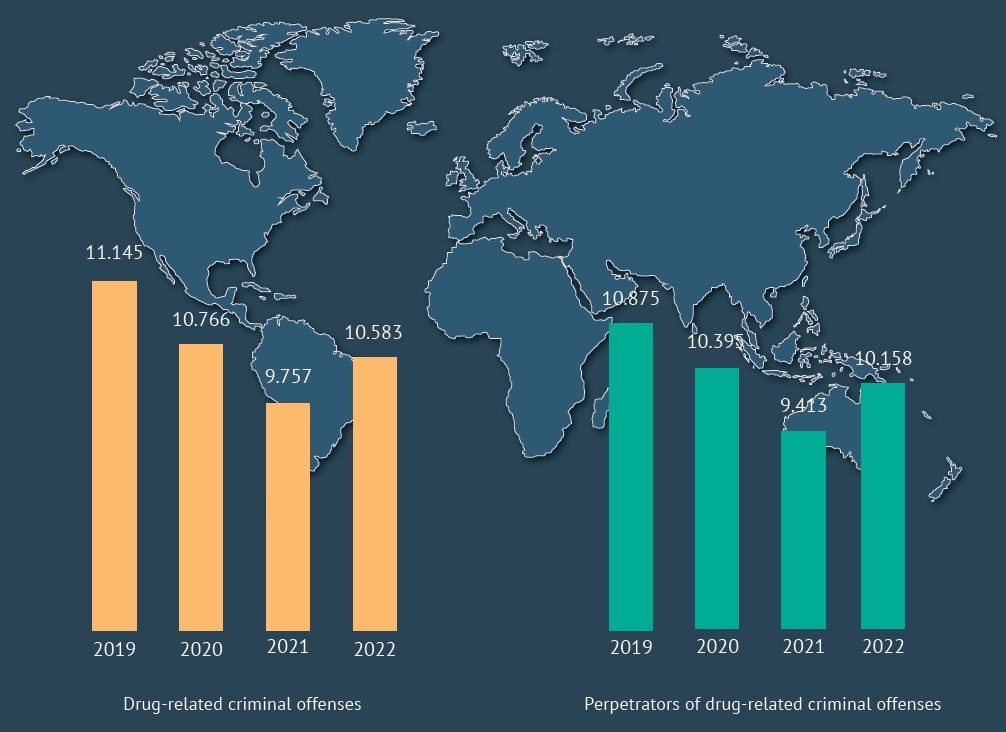
The war in Ukraine did not affect the drug smuggling quantities and routes in Serbia, and official data on seizures related to citizens of the Russian Federation and Ukraine showed that they accounted for a negligible percentage of the total number of perpetrators.
Serbia is mostly an area of transit to the Western European and Eastern criminal markets, and the final destination only to a lesser extent. Manufacture of drugs is less prevalent, since it refers only to certain types of psychoactive controlled substances (marijuana and synthetic drugs) and mostly for the local market needs. Marijuana, cocaine, heroin and synthetic drugs (including precursors) are the most common types of drugs which OCGs deal with. Marijuana is still the most widely represented drug on the illegal market, and in recent years this has also happened with cocaine and synthetic drugs. Recently, there has also been an increase in smuggling, that is, diversion of pharmaceuticals and their use for non-medical purposes.
In the past four-year period, i.e. between 2019 and 2022, the number of drug seizures in Serbia increased by almost 50% against the previous four-year period. More than thirty tons of narcotics were seized – mostly marijuana (28.4 tons), heroin (385 kg), amphetamine (437 kg and nearly 186,000 tablets), cocaine (102 kg), ecstasy (44 kg and 438,900 tablets) and other narcotics (378 kg and 3,165,090 tablets). Record seizures were registered in 2021 – a total of 8.8 tons.
Cocaine
Global and Regional Nature of the Issue
Cocaine is distinguished by increased demand, which is also accompanied by greater production. The main producer is South America, from which cocaine is smuggled to Europe in shipping containers via different routes, mostly seaports. From 2020 to 2021, the cultivation of the coca plant increased by 35%, which was a record increase ever since 2016, to which the UN Office on Drugs and Crime (UNODC) also cautioned. The world cocaine supply has increased significantly, which will result in the emergence of new markets. The American continent, as well as the Western and Central Europe, are still the main markets, but the use of cocaine is also increasing significantly in Africa, Asia and Southeast Europe. The presence of cocaine in the EU has risen significantly, and the increase in its purity has been unprecedented.
Balkan OCGs are among the world’s biggest cocaine smugglers.
They form associations according to their geographic origin, shared criminal past and absence of a language barrier. According to some estimates, they are responsible for as much as 60% of cocaine that enters Europe through ports in Spain, the Netherlands, Belgium, Germany, Croatia, etc.
These groups organize its purchase, transfer, receipt, further transport and sale in Western European countries. Certain quantities of cocaine are smuggled to Bulgaria and Turkey, where they are exchanged for heroin. Smaller quantities remain in the Balkans, including Serbia.
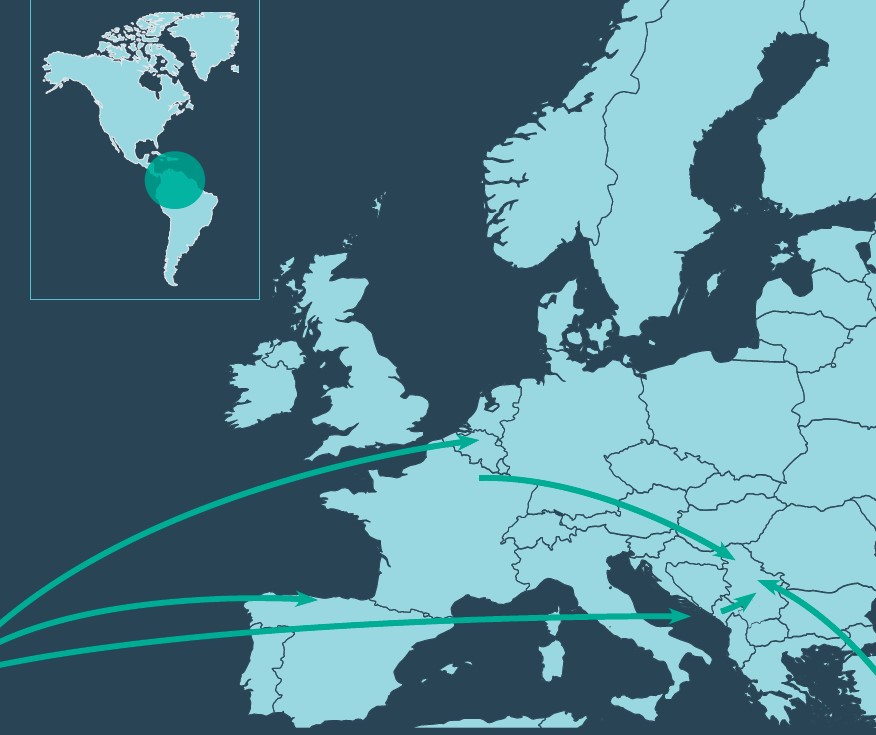
Situation in Serbia
The drug market in Serbia follows the global trend of increased presence of cocaine, which can be seen from the fact that the seized quantities of this type of drug in Serbia in 2022 were more than three times higher than in 2019. The smuggling of cocaine into Serbia is mostly organized by the aforementioned Balkan OCGs, which include those from Serbia. They hold all important positions in the international cocaine smuggling and trafficking chain, both in the countries of origin in South America and in European ports and cities. Their cooperation is synchronized and well organized, but frequent seizures of large quantities of cocaine, cutting of smuggling chains and, in some cases, mutual competition frequently cause conflicts that result in murders in European countries and the region. Like before, money obtained through the sale of cocaine is distributed in such a way that a third is invested in the purchase of new quantities, while two thirds are placed in legal flows. Money is still most frequently transferred to bank accounts of offshore companies and then invested in companies that operate in the region, especially in the fields of construction engineering, tourist industry, hospitality services and games of chance.
Cocaine is smuggled into Serbia from the direction of Western Europe, Turkey and Montenegro.
All seized cocaine in Serbia is in the form of the hydrochloride salt. There have been no seizures of so-called crack cocaine in our country. About 99% of the total mass of cocaine seized in the last two years of the analyzed period had a purity higher than 20%[1]. Judging by the samples, the mass fraction of cocaine is high in large seizures, which means that they are extremely potent, very pure and usually not cut with other substances. Seized samples of smaller mass usually contain more than 20% of cocaine and they are mostly cut with paracetamol, creatine, caffeine or lactose. In 2022, the number of uncut cocaine samples was higher than in the previous period.
Since a high-level threat from smuggling and trafficking of cocaine primarily exists on the international level, only to be transferred later to individual countries, the Ministry of Interior of the Republic of Serbia has participated in numerous joint operations with international organizations and police forces of other countries.
One of these operations was aimed at breaking the chain of criminal structures from Serbia and neighboring countries. The operation was carried out by Serbian MoI members in coordination with Europol and Eurojust. In several cities in Serbia, 13 members of an organized crime group, made up of several independent “cells”, were arrested. The group was linked to the seizure of a total of seven tons of cocaine in 2020, out of which about five tons were seized in the Netherlands Antilles, 1.2 tons in Belgium and 743 kg in the Netherlands.
On the basis of information provided by the Serbian police, 421 kilograms of cocaine were seized In Hong Kong in April 2019, while in May that year, 602 kilograms of cocaine were seized within a parallel investigation conducted in Serbia, Croatia, Czechia and Switzerland.
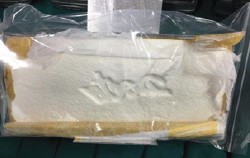
In March 2020, in cooperation with the police forces of Croatia, Slovenia, the Netherlands, Austria and Germany, nine kilograms of cocaine and other drugs were seized.

In 2020 and 2021, in eight countries on two continents, a parallel investigation was conducted with the US Drug Enforcement Administration (DEA) and the police forces of Spain, Croatia, Germany, Slovenia, Bosnia and Herzegovina and Colombia, under the auspices of Europol. It resulted in the seizure of 2.6 tons of cocaine, 324 kg of marijuana, EUR 612,000, etc.
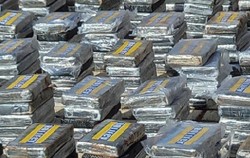
In early 2022, based on data provided by the Serbian police, the UK National Crime Agency (NCA) stopped a truck with Serbian license plates in the country, driven by a Serbian citizen, and found twenty kilograms of cocaine.
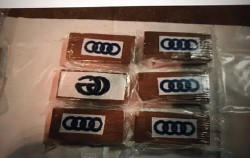
In Serbia, an outstanding seizure of eight kilograms of cocaine was made in Belgrade in November 2022. The cocaine was smuggled from the Netherlands.
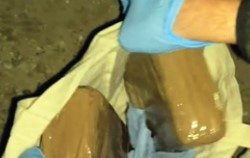
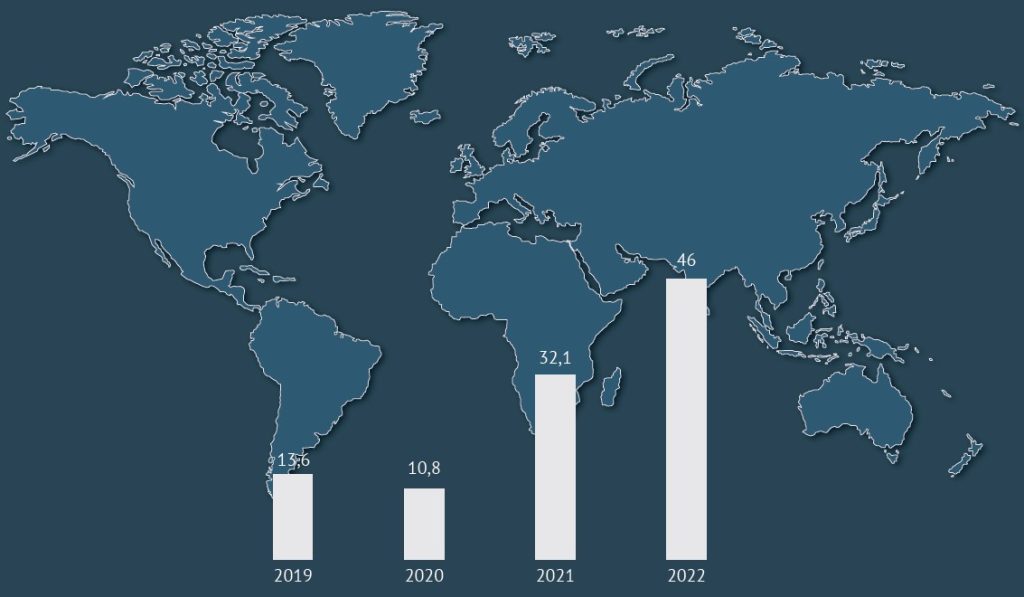
Expected Future developments
► Due to a greater demand on the criminal market, cocaine smuggling and trafficking will represent a lucrative OCG activity, because of which they might fight against each other in order to gain dominance on the cocaine market.
► Members of the so-called Balkan cartel will continue to play a leading role in cocaine smuggling towards European countries.
► One can expect the appearance of cocaine in specific forms, which are not easy to recognize or accessible for use, but require chemical conversion in clandestine laboratories.
Marijuana
Global and Regional Nature of the Issue
Marijuana is traditionally the most widely present drug on the international and European illegal drug markets.
The Netherlands, Switzerland, Czechia and Slovakia hold prominent places in the production of marijuana in Western Europe, while Albania, Turkey and Romania stand out in Southeastern Europe.
It is grown both outside and in labs and its consumption is characterized by an increase of negative consequences to mental and physical health, because nowadays it contains almost 50% more THC than twenty years ago.
According to the World Drug Report for 2022, the global demand was spurred by the legalization of cannabis in certain countries, which resulted in an increase in its daily use, primarily among the young population.
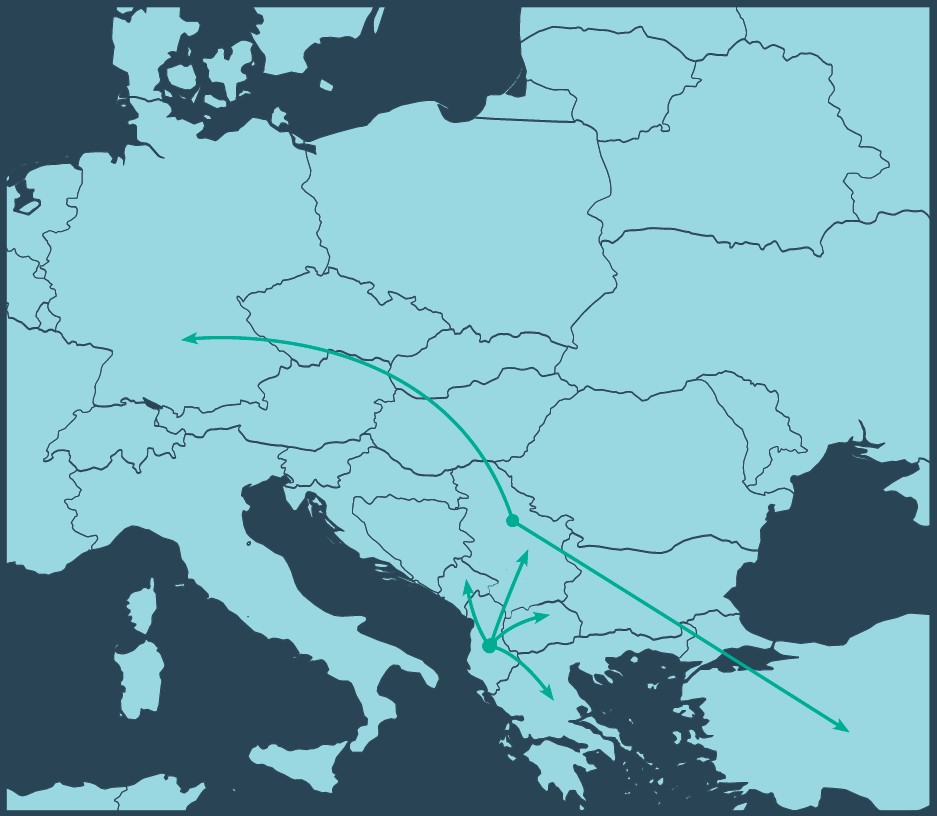
Situation in Serbia
Marijuana is still the most prevalent drug type on the Serbian drug market, which is evident from the fact that it accounts for more than 90% of the total quantity of seized drugs. Since it is also produced in our country, marijuana is far more accessible and cheaper than other drugs, which makes it one of the constantly demanded drugs.
In recent years, the production of marijuana in both natural and artificial conditions has increased. The number of discovered farms and laboratories for its cultivation is one of the indicators of increased production under natural conditions and increasing expansion of production under controlled conditions in labs. In 2021, 114 outdoor farms and 53 indoor laboratories of marijuana were detected, and in 2022, this number increased to 132 outdoor farms and 62 indoor labs. The stalks of different heights and different stages of maturity that have been found and the seizures of marijuana in different stages of production represent an indicator of increased production, which is a clear consequence of the intention of illegal producers to have a constant and “certain” amount of “goods” throughout the year.
The soil in Serbia is suitable for marijuana growing, and the use of modern technical tools has facilitated not only the organization of this process, but also the production process itself and greater yields, and, consequently, also the increase of profit.
As for the production of marijuana under artificial conditions, greater production is accompanied by greater investments, from the lab equipment and improvement of conditions in the labs to the purchase of high-quality equipment that is also used in legal agricultural production. Laboratories are situated in rented houses in the suburbs and sparsely populated areas or in facilities that are adapted for this purpose. The transportation of thus produced marijuana is less risky than that from other areas, and so the price on the drug market is lower. The genetically modified marijuana, or so-called skunk, is an exception, because its price is usually higher than the price of non-GMO marijuana. Marijuana produced in these laboratories is partly distributed in the country, and partly transported to Western European countries through illegal channels.
In addition, marijuana is smuggled from Albania, as the largest producer in the region, toward North Macedonia, Greece and Montenegro. It is also delivered to AP K&M, and from there to central Serbia. Part of the smuggled marijuana remains on the illegal market in central Serbia, and another part is smuggled into EU member states. Moreover, it is also smuggled through the central Balkan route in the opposite direction – it is transferred in larger quantities to Turkey for the purpose of sale and exchange for heroin.
As for “skunk”, OCGs from Serbia participate in its production in illegal laboratories in Western European countries, mostly in Austria, Czechia and Spain. In order to increase the yield and obtain “the best possible properties” of this type of modified marijuana, these groups use different technological innovations.
In the period between 2019 and 2022, about 7.1 tons of marijuana were seized per year on the average. As for nearly 80% of mass in all marijuana seizures in this period, these were large seizures (the mass of an individual sample in the seizure was greater than or equal to one kilogram). All marijuana samples in large seizures were very potent because they contained psychoactive THC in a mass fraction significantly higher than 0.3%. Most of the seized smaller mass samples, which belonged to the category of small seizures, also contained more than 0.3 percent of THC. In the recent period, cannabis with less than 0.3% of THC has appeared but with added new psychoactive substances belonging to the group of synthetic cannabinoids.
The largest marijuana farm was detected in the municipality of Stara Pazova in late 2019, when 37,169 marijuana plants weighing a total of about 1,776 kg were seized.
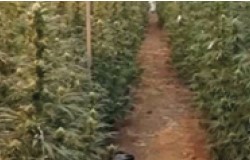
In central Serbia, two farms with 917 kg and 750 kg of cannabis, respectively, were detected in 2021, while in May 2022, an improvised marijuana laboratory with 500 cannabis plants was found.
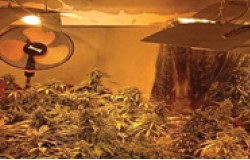
A total of 2.4 tons of marijuana acquired in the territory of AP K&M were seized on three occasions at the Gradina border crossing towards Bulgaria in 2019, while in March 2020, at the Vatin border crossing towards Romania, 782 kilograms of marijuana were seized, worth a total of about EUR 1.5 million.
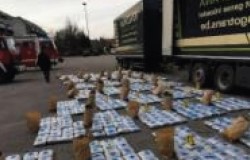
In mid-2021, a joint operation with the Spanish police resulted in the arrest of OCG members involved in the production of marijuana in Spain and its sales in EU member states. In Spain, 31 people were arrested, 15 clandestine laboratories were discovered and 858 kg and 14,329 stems of marijuana were seized. In Serbia, four persons were arrested and a large amount of illegally acquired money and other things were seized.
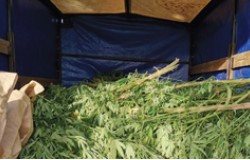
In late 2022, in cooperation with the Spanish police, members of an OCG involved in the production of marijuana under artificial conditions in Serbia and Spain were arrested. In Spain, 19 people were arrested and six clandestine laboratories were found, while in Belgrade, a large amount of laundered money was found.
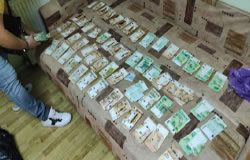
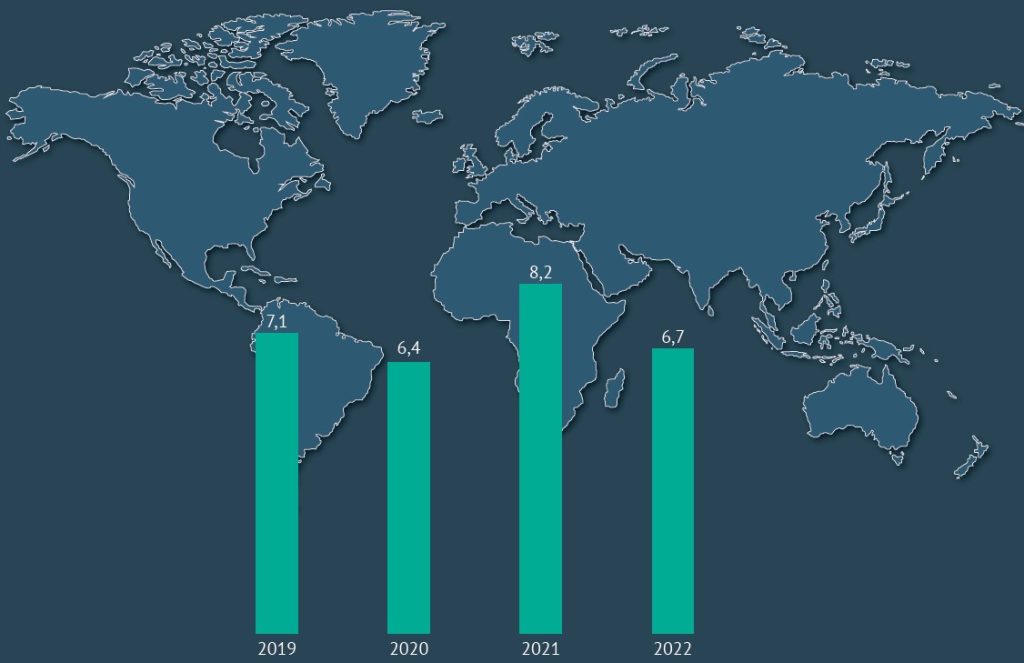
Expected Future developments
► Since cannabis growing techniques in laboratories have evolved in nearly all European countries, this trend is also expected in our country, so we can assume that investments in the production of marijuana under artificial conditions will continue as will the equipping of laboratories with sophisticated tools and improving the growing conditions in artificial environments. High earnings are the main reason, in view of the fact that cannabis grown indoors can have three to four yields in a year.
► The so-called Balkan route will continue to be used for the smuggling of marijuana in both directions.
► We can expect that cannabis containing less than 0.3% of THC and different new psychoactive substances will appear more intensively. An increase in foodstuffs with THC is also possible.
► In addition to this, we might encounter the conversion of different natural cannabinoids into synthetic ones under illegal conditions as well as their application to cannabis with a THC content lower than 0.3%.
Heroin
Global and Regional Nature of the Issue
The heroin route begins in Afghanistan, goes through Iran and Turkey, and then its largest part goes through the Balkans, that is, the so-called Balkan route, which is still the main smuggling route to the countries of Western and Central Europe. Heroin is smuggled to Serbia from Montenegro.
It arrives to central Serbia from the direction of AP K&M.
According to UNODC estimates, about 60-65 tons of heroin are smuggled every year from Turkey through Southeast European countries, that is, through Bulgaria and to a lesser extent through Greece.
Larger shipments of heroin are believed to be stored in the region and rerouted to Hungary, as well as through North Macedonia and the territory of AP K&M to Albania, and from there to Italy, or through Montenegro to Bosnia and Herzegovina and then to Croatia.
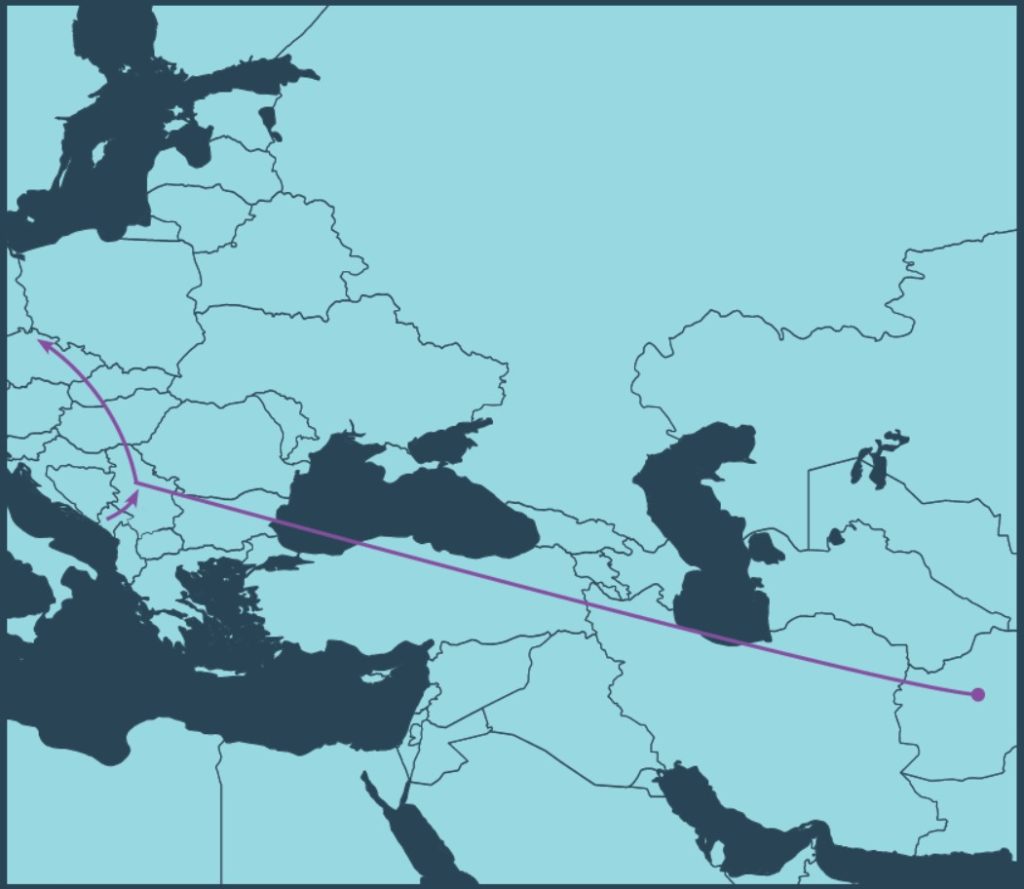
Situation in Serbia
Heroin which arrives in Serbia mostly originates from Afghanistan and is most frequently purchased in Montenegro, Albania and Bulgaria. Although smaller quantities remain in Serbia, its largest part is intended for the European drug market. Heroin arrives to central Serbia from AP K&M.
Heroin is smuggled into Serbia by land, mostly through border crossings, hidden in specially made secret compartments in buses and passenger and cargo vehicles. Larger quantities are smuggled in trucks which transport legal goods.
OCGs which dominantly deal with heroin smuggling are known for their strict internal discipline, preparedness to use violence, but also for their family ties. Albanian criminal groups belong to the most organized, strongest and largest organized structures and they hold a high position in the international hierarchy of drug smuggling chains, which are made up of Albanians from Serbia (from AP K&M and the municipalities of Bujanovac and Preševo) and Albania. The fact that the already mentioned heroin smuggling route – better known as the Balkan route – which leads to Western European countries, passes through Serbia has contributed to the development of Albanian OCGs in our region. Groups from AP K&M also have connections with some terrorist and extremist activities, which are largely financed from drug smuggling. Competent Serbian authorities are unable to conduct investigations in AP K&M, which makes the detection and identification of OCG members difficult. Albanian and central Serbian groups cooperate when their sellers and couriers obtain heroin in AP K&M. Belgrade, Niš and Novi Pazar are the main heroin distribution centers.
Current developments indicate that there has been a decrease in the smuggling and trafficking of heroin, which can be seen from the quantities of seized heroin in the last four years – in 2022, they were almost three times smaller than in 2019. This is because OCGs which control this criminal activity on a transnational level more and more frequently decide to smuggle heroin using maritime routes, mainly from Turkish ports, directly to ports and entry points in EU member states, bypassing Serbia. Also, with increasing frequency, smugglers decide to smuggle heroin that was transported through Albania to the territory of AP K&M using maritime routes to Italy and Western European ports.
All of the seized heroin was alkaline. Seizures of heroin in the form of the hydrochloride salt are very rare. Heroin samples in large seizures are extremely potent, of high purity, but frequently cut with substances such as caffeine and paracetamol. Seized samples of smaller masses have lower purity and are cut with large quantities of the same substances as in large seizures.
In 2019, 77 kg of very pure heroin, which had been bought in Turkey, was seized in the Belgrade settlement of Mladenovac.
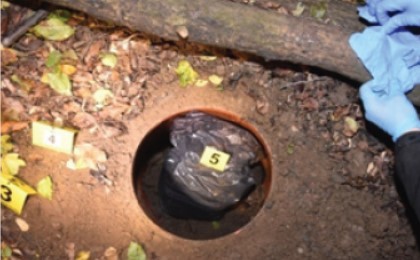
In cooperation with the police forces of North Macedonia and Austria, about 17 kg of heroin and 5 kg of cocaine were seized in 2019, and this marked the end of the OCG which had long dealt with the smuggling of large quantities of these drugs through the Balkan route.

In February 2020, Germany seized 12 kg of heroin on the basis of information provided by the Serbian police.
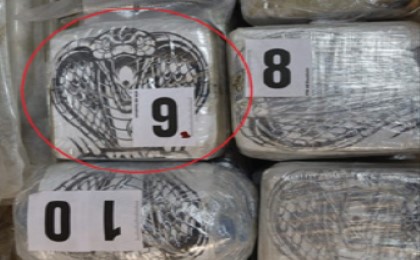
In early 2021, within a parallel investigation with Bulgaria and in cooperation with the DEA, a total of 22 kg of heroin were seized (20 kg in Bulgaria and 2 kg in Serbia).
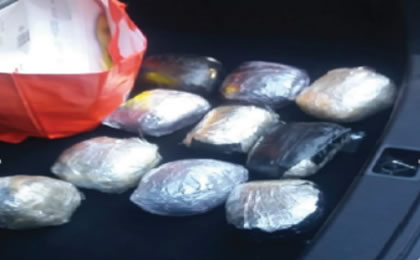
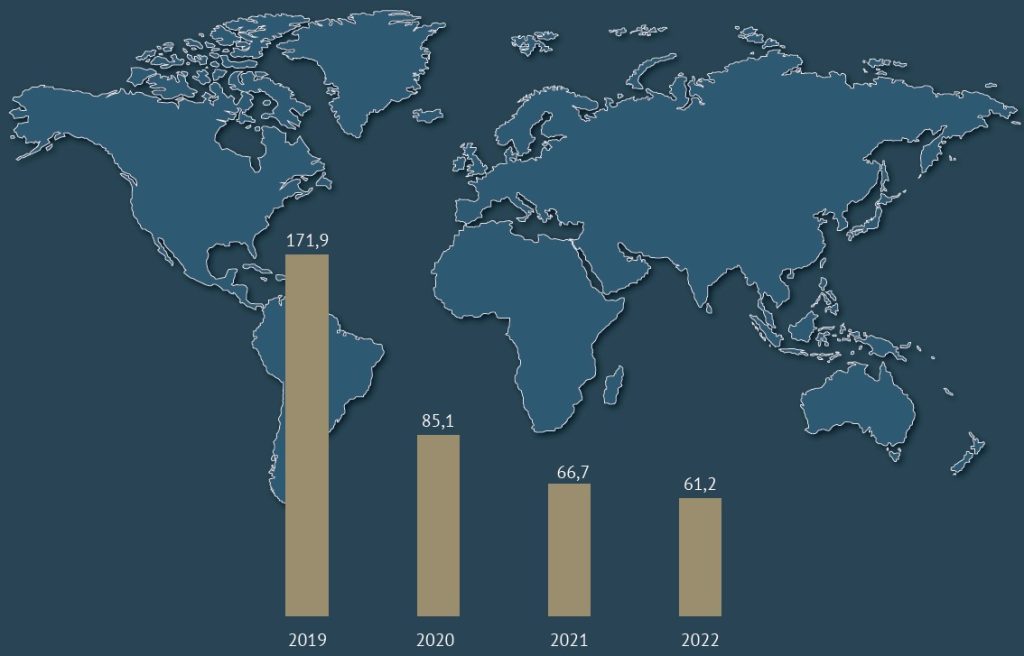
Expected Future developments
► The trend of acquiring and transporting heroin from AP K&M will continue. Also, since the quantity of heroin smuggled through Serbia has decreased in the past few years, one can expect that this trend will continue in the coming period.
► Due to the reduced volume of heroin smuggling, alternative types of opioids in the form of synthetic analogues of fentanyl may appear. This trend has already been observed in Northeastern Europe. The recognition of such potential dangers should result in the prediction of risks from substances and greater precautionary measures in the treatment of psychoactive substances in the field and in forensic laboratories.
Synthetic and New Psychoactive Drugs
Global and Regional Nature of the Issue
The illicit synthetic drug market is characterized by constant innovations in the production methods and substances, as well as greater financial investments in their production. These drugs are mostly manufactured in EU member states and the distributed globally. According to data from the 2022 Report on Drugs of the European Center for Monitoring Drugs and Drug Addiction, the production of the most common synthetic drugs (amphetamine and methamphetamine) has been stable in the European Union, with an upward trend in the past few years. Amphetamine is very accessible, also with an upward trend, while methamphetamine is also showing signs of growth on the illicit drug market. Laboratories for the production of synthetic drugs are becoming more modern in terms of technology, as well as more functional and with larger capacities, which means that production growth can also be expected in the coming period. The Western Balkans, where amphetamine, methamphetamine and ecstasy are the most common synthetic drugs, is becoming the place where synthetic drugs are being produced more and more frequently. This is because their production is simple, cheap and quick, which has otherwise radically transformed many drug markets.
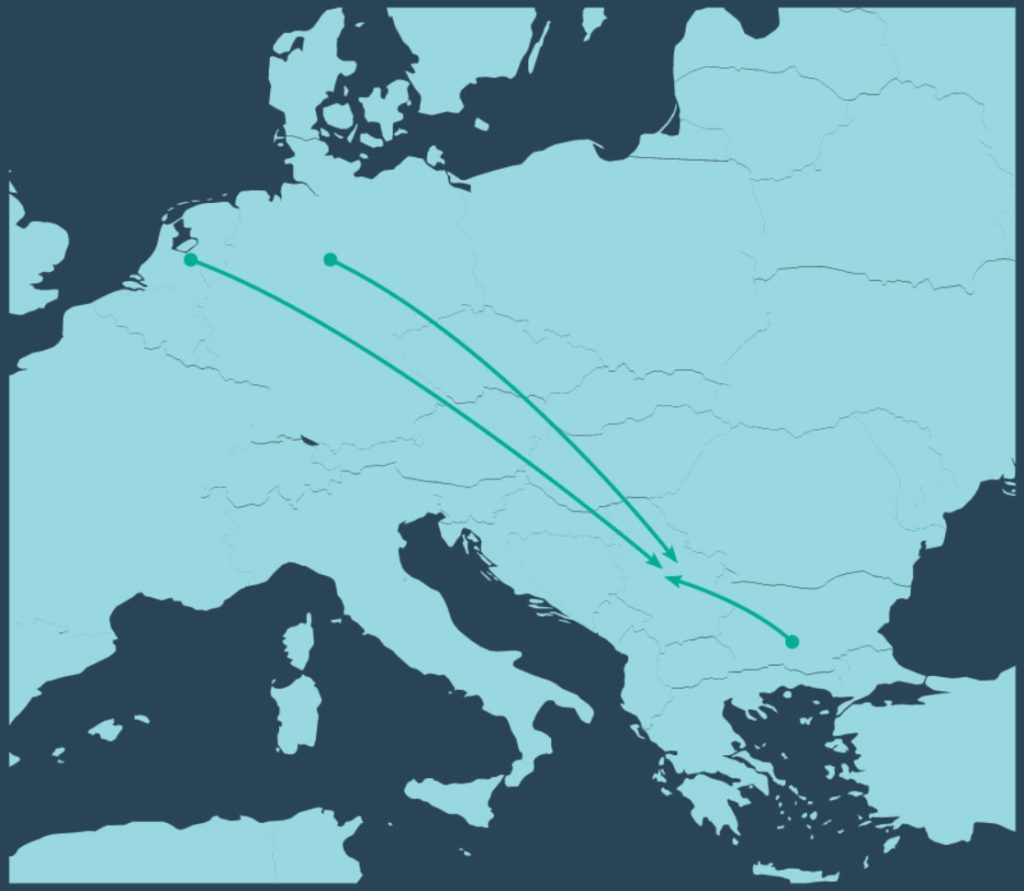
Situation in Serbia
In the recent years, the presence of synthetic drugs, especially amphetamine, has increased in Serbia. The number of users of these drugs is constantly growing, primarily due to their accessibility and low price. Users are young, but their age limit is dropping even further. Synthetic drugs are entering the illegal market mainly from Western Europe, especially from the Netherlands and Germany, but part of them are also arriving from Bulgaria. Multiple types of synthetic drugs are present, and they appear everywhere and among all social strata.
In addition to their being widespread, a problem in the fight against synthetic drugs is also their chemical diversity, because a small change in the chemical structure results in a new psychoactive substance. Such substances have so far appeared sporadically in Serbia, in quantities that do not cause much concern (five or six substances weighing several hundred grams in total). The emergence of new or modified psychoactive substances requires continuous education, improvement and specialization of work methods of competent authorities, since their detection is frequently impeded by conventional work methods.
Larger quantities of amphetamine (“speed”) have appeared as a result of a new production method which appeared in the past few years – it is obtained through simple crystallization from amphetamine oil, which is much easier to smuggle. The crystallization of amphetamine in makeshift laboratories (at home) has resulted in a decrease in purchase price. At the same time, seizures of amphetamine oil have increased, which indicates that the last stage of amphetamine production is being performed in Serbia. In 2021 and 2022, a total of 378,886 ml of amphetamine oil were seized. The new method of production led to a decrease in the number of synthetic drug laboratories, because illegal proceeds are now easier to earn through a process that does not require a chemist, purchase of precursors and laboratory equipment, frequent changes of locations, physical security, etc.
The largest quantity of seized amphetamine belonged to the medium mass category (mass of the individual sample is more than ten grams and less than one kilogram). The purity of amphetamine samples varied, and there was no regularity. As for MDMA, in 2021 and 2022, more than 90% of the seized mass was in the form of tablets and belonged to large seizures (mass of an individual sample in the seizure was greater than or equal to 1 kg / 1000 tablets). Crystal MDMA samples were pure, while different diluents and binding agents were added to tablets (most frequently microcrystalline cellulose or lactose). Generally speaking, in the last two years of the observed period, more than 93% of the total mass of seized MDMA had the purity of over 40%.
In August 2021, in the territories of Belgrade and Kragujevac, 119 kilograms of MDMA were found and seized.
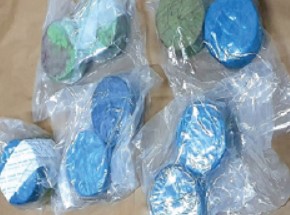
In March 2022, 11,962 grams of the synthetic cannabinoid 5-fluoro-MDMB-PICA/5F-MDMB-PINACA, which is the synthetic replacement of hashish, were seized in Belgrade.
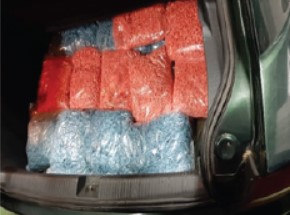
At the Gradina border crossing, 75,435 MDMA tablets, 108,827 amphetamine tablets and nearly five kilos of cocaine were seized in 2021.
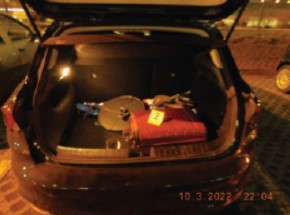
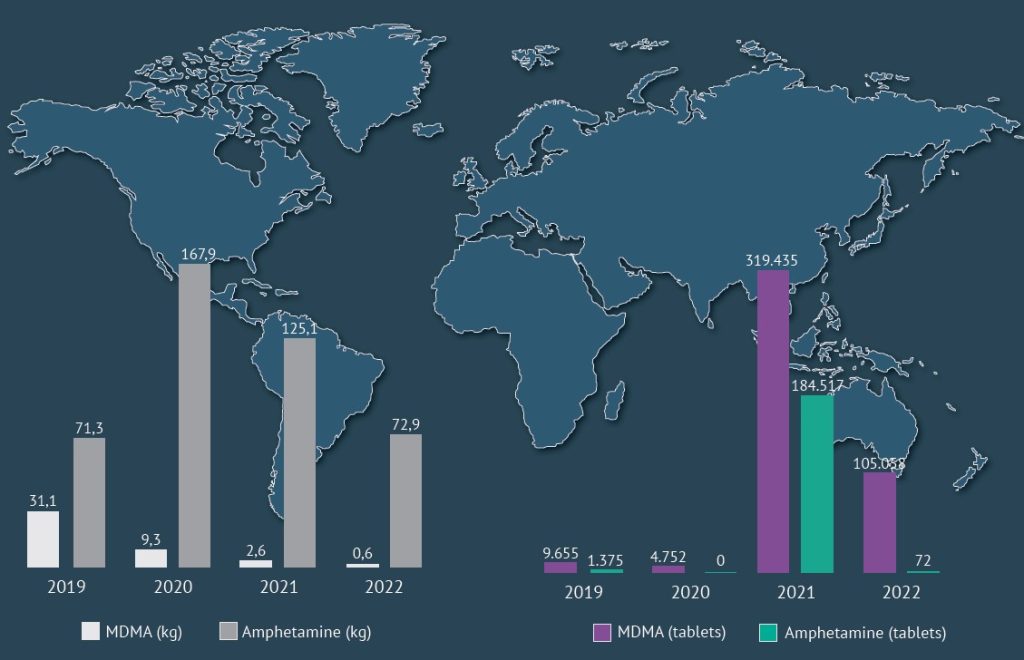
Expected Future developments
► Synthetic drugs and new psychoactive substances will continue to be a great danger to the health of young people, especially those between 18 and 35. Low price and simplicity of production will continue to play an important role in their accessibility.
► An additional danger in the production of synthetic drugs is the generation of significant quantities of chemical waste, which illegal producers dump in public places, endangering the environment.
Precursors and Pre-Precursors
Organized Crime Groups from Serbia are involved in the acquisition and distribution of precursors, and between 2019 and 2022, the largest quantities of pseudoephedrine, benzyl chloride and sulfuric acid were seized.
Once a precursor is placed under domestic and international control, criminal structures attempt to come up with new methods of production, or new precursors that are not under the competent authorities’ control. In addition to precursors, OCGs also produce and smuggle pre-precursors – chemical substances from which precursors are obtained through simple chemical reactions – which are then used in the production of psychoactive controlled substances. When a precursor becomes controlled, seized amounts of the substance drop drastically, while the amount of seized alternative precursors or pre-precursors increase significantly.

In late 2021, on a family estate near Požarevac, a total of 20,090 kg/liters of precursors were discovered and seized, as follows: 16,537 liters of benzyl chloride, 1,800 liters of hydrobromic acid, acetic acid, 2,650 liters of acetyl chloride, 3,700 kg of paraffin, 288 liters of eugenol and 120 liters of engine oil.
Expected Future developments
► The production and smuggling of precursors will continue in the next period, since none of the synthetic psychoactive substances can be produced without them.
Diversion of Pharmaceutical Drugs
There has recently been a sharp increase in the diversion of pharmaceutical drugs for non-medical purposes, mostly of sedatives, sleeping pills, painkillers, etc. The most frequently seized pharmaceuticals were: Ksalol, Diazepam, Xanax, Tamol-XX, Bensedin, Rivotril, Lorazepam, Zopiclon, Sanval, Belbien and other tablets or capsules.
Individuals and criminal groups in Serbia purchase drugs which are on the List of Controlled Psychotropic Substances and smuggle them in vehicles through Hungary and Croatia to EU member states, where their price is many times higher and issuance control is stricter. Most of the smuggled drugs are produced by the domestic pharmaceutical companies Galenika and Hemofarm, although some pharmaceuticals are also produced by foreign pharmaceutical companies that have representative offices in Serbia. Some of the pharmaceuticals are shipped from AP K&M.
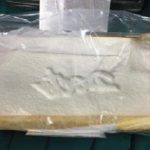
In 2020, 99,862 tablets of Ksalol and 18,890 tablets of Rivotril were seized on the Horgoš border crossing towards Hungary from a truck that was going to Sweden and Norway.
Expected Future developments
► Due to major differences in prices and stricter control of the issuance of pharmaceutical drugs from a certain group, particularly in the EU member states, the smuggling of pharmaceuticals, i.e. their diversion for non-medical purposes, will continue, which creates a great risk to public health.


